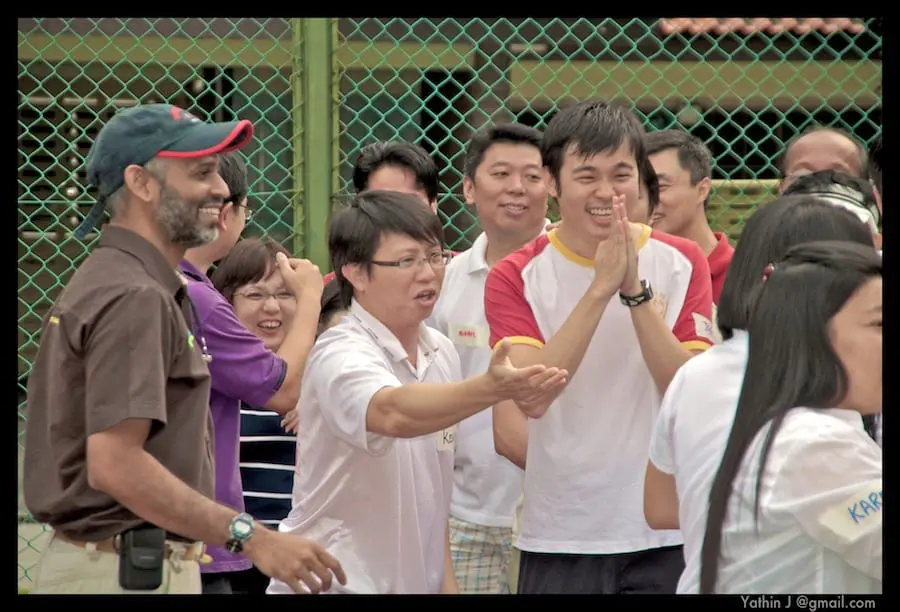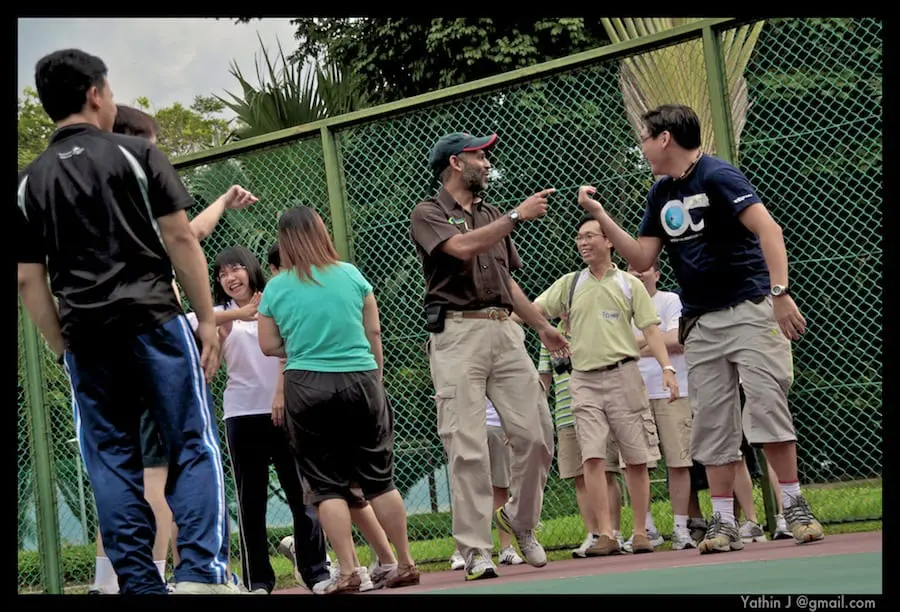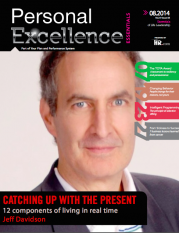As a practitioner in developing learning programs, I have found Gagne’s 9 events helpful in sequencing my learning content for the training programs I have conducted in Singapore and across Asia. The application of the 9 events has been instrumental in engaging my learners, from Generation Ys to adult learners.
By effectively engaging your learners, you can enhance their learning experience and ensure better retention of knowledge. Let’s look at the 9 events, and I will share with you the approach I take. Moreover, this theory, outlined by Robert Gagne, details nine instructional events and their corresponding cognitive processes.

Energizer activity conducted Engaging your learners
- Gaining attention (reception)
- Informing learners of the objective (expectancy)
- Stimulating recall of prior learning (retrieval)
- Presenting the stimulus (selective perception)
- Providing learning guidance (semantic encoding)
- Eliciting performance (responding)
- Providing feedback (reinforcement)
- Assessing performance (retrieval)
- Enhancing retention and transfer (generalization).
Do consider, how you “ gain reception” on part of the leaners you will be engaging. What I mean here, is for you to consider activity driven exercises that you can incorporate in a classroom or in a hall to gain the buy in of your learners to get excited and interested, to your learning content. Some trainers have labeled ice breakers, and energizers as activity driven exercise to meet event 1 described by Gagne. When conducted without any relevance, it deteriorates into a childish game. Energizers and ice breakers when used appropriately can be powerful attention gainers. Even a field visit can achieve a similar out come.

Bringing Learning to Life Through a Museum Visit
What I mean here is the field visit initiated by my Lecturer, many years ago, Dr. Ralph Blunden was delivering a lecture on advance learning theory to my class on a Sat morning. Little did he realized that half the class was falling asleep and the other half was just confused as he tried his very best in a monotone lecture to keep us awake.
It was a losing battle and it dawned upon him that all the talking that he was doing was not helping us learn one bit. He paused, took a 2 minutes break and he asked all of us if we can commute out to the museum. The bunch who were dosing off were the first to reply. Anything to get them out of class was a temporary reprieve that they embraced. We agreed that we could go to the museum.
In the museum, he carried on with his lecture on advance learning theories. He shared with us the thought processes involvied in drawing a portrait and how some artists even captured the political undertones in the images they drew. That astounded all of us, theoretical knowledge came alive and we learnt.
Gagne Event 1 – Gaining attention
Consider, how you would want to undertake this in the curriculum that you deliver. It will require you to be innovative and it will also require you to plan. In this blog, I would also like to share with you energizers that can you can use. The key here is to make the activity relevant to the learning outcomes you will cover.
Little Known FACTs (Gain attention activity – mass groups), another of our top ten activities
Purpose: To increase the level of personal disclosure
Participants: Min 10 to maximum any number
Time: 10 – 20 mins
Resources: Index cards or stick on “post its”
Activity conduct:
Ask the participants to write about little known facts about themselves, in the index cards or the “post its”. Collect the cards from one group and call them the “confessors”. The cards that have been collected will be given to the other group and they will told not to look at the contents of the card. This group is called “Interrogators”.
All the interrogators must stand up and place the index cards against their foreheads, showing the written side. Interrogators must follow the rule by not reading the written card.
The action begins as the interrogators find the person whose card they are showing on their foreheads. They walk around the room, ask questions, and identify the confessor. The confessor must say yes, when approached and asked by an interrogator.
Once the confessor is tracked down, the interrogator asks a series of close- or open-ended questions until they identify the LKF. Then, switch roles.
Like us on Face book if you had found this useful. Do drop us an e-mail, and we will explain how to debrief this activity.
About the Author: Ebnu Etheris Ma.IDT, B.Hrd
Related Posts
- Categories: Experiential learning, Growth and culture
Here is an energizer we have used to engage teams and participants. It has the elements of purposeful fun, movement and getting folks engaged before you start your training sessions. We have the instructions and a video clip you can use to run this on your own.
- Categories: Experiential learning
Here is a quick youtube tutorial on incorporating Kahoot in your training programs. Using tech to facilitate training sessions. From icebreakers to team building using Kahoot can happen in face to face sessions too.
Top 10 activities
This blog will showcase top 10 experiential activities that we have conducted in our training programs. Included are models associated with experiential learning, team dynamics, understanding personality and leadership. We will showcase crisp summary of good books we have read on this blog as well.
Ebnu Etheris
MA.IDT and B. Ed & Trn
Founder Teamworkbound
Magazine Feature

Personal Excellence Magazine (Aug 2014 issue) based in Canada featured our article.

Human Resources Magazine (July 2012 issue), featured Teamwork Bound views on what it takes to engage senior managers.
Our Evaluations
Blog articles
Get started with Teamwork Bound
Want to learn what Teamwork Bound can do for you? See for yourself with a free trial, tests and short in house speaking engagements. We will assure you that our program evaluations meet 85% percentile score, failing which we will not charge for our training sessions.
